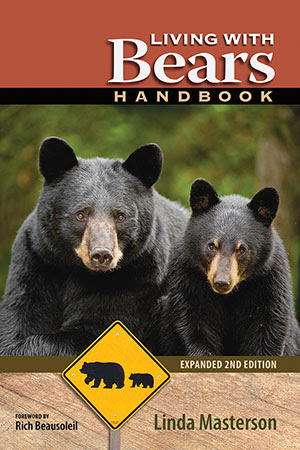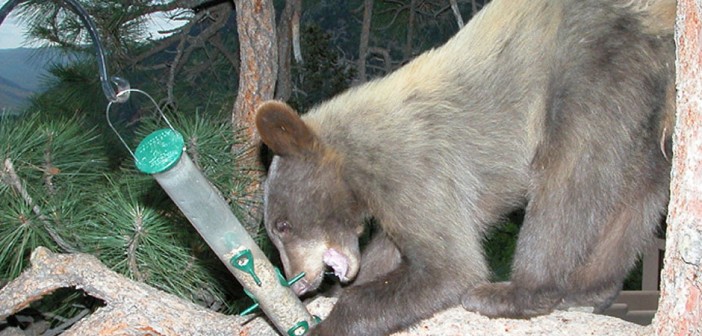(Featured image courtesy Bill Levy. All rights reserved.)
LOVELAND, COLORADO: Your bird feeder could lead to the death of a bear whose only “crime” is being smart, industrious and very good at finding food, according to bear expert Linda Masterson. In her new book, Living With Bears Handbook, Masterson explains that bear feeders, more commonly known as bird feeders, are one of the biggest causes of human-bear problems.
A study in New York State showed that more than 80% of human-bear conflicts could be traced back to the bear’s first encounter with a bird feeder. Bird feeders are the ultimate carry-out food for bears: easy to get at and filled with tasty, nutritious natural foods that would take a hungry bear many hours of foraging to find in the wild.
A seven-pound feeder filled with black oil sunflower seed holds more than 12,000 calories; that’s enough nutrition to keep a 250-pound bear fed for two or three days. To make matters worse, high-calorie natural foods like seeds and nuts are in short supply in the spring; bears must be content with tender spring grasses and plants and the occasional remains of an animal that died over the winter. So it’s not surprising that a bear might be eager to take advantage of the unexpected bounty.
Once a bear gets comfortable around your home, it’s only a matter of time before it starts exploring other culinary opportunities, including garbage, pet food, fruit trees, gardens and chicken coops. Allowing bears to associate people with food eventually leads to thousands of bears being killed each year.
Masterson says there are many ways to attract birds without feeding bears, including water sources, nesting boxes, nectar-providing flowers and sand and dust baths. Folks who just can’t quit should switch to hull-less seed and bring all feeders, including hummingbird feeders, inside every night. Never store birdseed, pet food or anything with an odor or calories on or under your deck or porch.
For much more on understanding bears, preventing problems, and getting your paws on a copy of Masterson’s comprehensive Living With Bears Handbook, visit www.livingwithbears.com
 Living With Bears Handbook, Expanded 2nd Edition
Living With Bears Handbook, Expanded 2nd Edition
$24.00 softcover, ISBN 978-1-936555-61-1
288 pages with over 160 photos / illustrations





